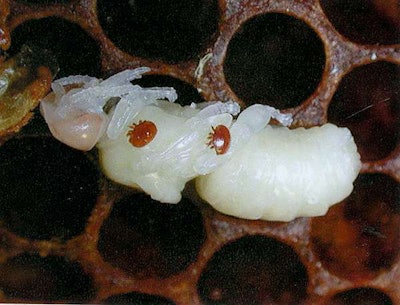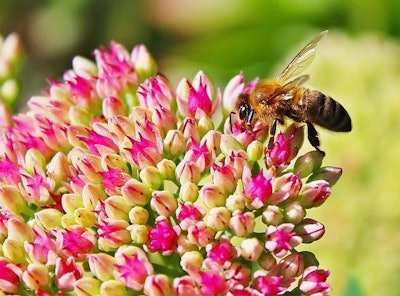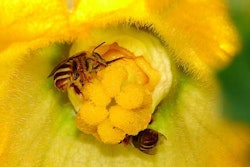 Varroa mites feed on bee larvae as well as lay their eggs on them.
Varroa mites feed on bee larvae as well as lay their eggs on them.Photo: beecare.bayer.com
The honeybee has to deal with multiple threats, but none as devastating as the varroa mite, according to the University of Florida. However, hope is on horizon for two different ways to possibly minimize the threat of these mites.
Varroa mites are parasites and feed on the blood-like substance of the worker bees and the larvae. Not only do the mites weaken the adult bees, they are also able to infect the larvae with a virus known as deformed wing virus. These infected larvae will not be able to fly as adults.
Colonies infected with varroa mites will die out in two to three years if left untreated.
One study by Chinese and Japanese researchers discovered that some plant-based tick repellents caused the mites to be unable to find their way into honeycombs with bee larvae to reproduce.
The paper, published in Cell Reports, determined that certain tick repellants activated transient receptor potential, or TRP, channels found on the mites’ front legs.
TRP channels are proteins that are found in various organisms. In humans they are used to perceive taste or temperature, while insects use them to sense pain. These channels had not been studied in parasites and varroa mites have been the first to be characterized.
The researchers believe this TRP channel plays a role in parasites’ sensing the host environment.
“Several plant-derived tick repellants activated the TRPA1 channel in Varroa mites but had no effect on the TRPA channels in honey bees and fruit flies,” said senior study author Tatsuhiko Kadowaki, an associate professor of biology.
The lab intends to explore what natural pesticides could be used to target these TRP channels.
“We’d like to further understand the roles of TRP channels in host-parasite interactions and the underlying molecular and cellular mechanisms of the adaptions necessary for successful parasitism,” he said.
 The USDA has a guide to creating habitats for these crucial pollinators. Click here to read.
The USDA has a guide to creating habitats for these crucial pollinators. Click here to read.Photo: pixabay.com
On the other side of the spectrum, beekeepers are trying natural selection to create a hardier honeybee that will not need the help of insecticides to kill off the varroa mites.
Commercial bee breeder Jeff Berta is part of a cooperative of about 100 beekeepers across the country who are trying to create this better bee.
One of Berta’s queen bees, Number 18 as she’s tagged, was born in a Vermont colony that has survived disease and cold winters. She was then artificially inseminated by Purdue University scientists, who have developed bees with a resistance to mites.
“The bees will take the mite and they will bite the legs and will chew on the mite,” Berta told Michigan Radio. “And if they bite a leg off the mite, the mite will bleed to death. So the bees are actually fighting back. That’s the type of genetic line that we’re after right now.”
All of Number 18’s offspring will have this natural defense against the mites. However, this is a delicate system that can be diluted if any of the offspring become queens that mate with random drones in the area.
“You have to constantly re-select and constantly have to have people very interested in working as part of this effort,” said bee geneticist Christian Grozinger.
For the method to succeed, beekeepers must shift from simply buying new bees to investing in creating a community of bees that have the traits necessary to survive mite infestations.










